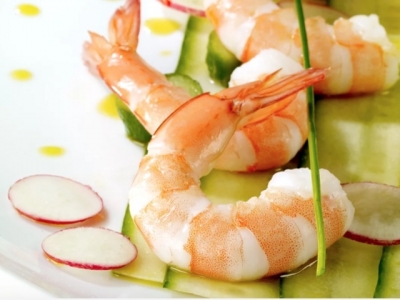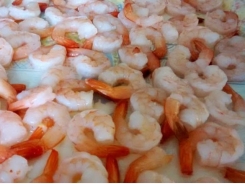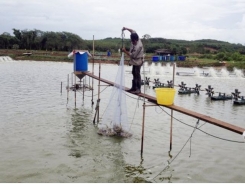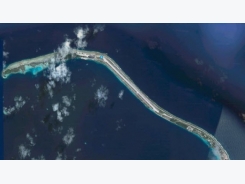Global shrimp prices continue to fall

BRUSSELS, Belgium -- Farmed shrimp prices are still yet to hit the bottom as good harvests, high US stocks and China’s smuggling crackdown send chills through the global market, Undercurrent News sources said.
“2002, after 9/11, was the bottom for the shrimp market. We are not there yet, but we are not far off,” an executive at a large shrimp trading firm told Undercurrent at the Seafood Expo Global in Brussels last week. “The bottom is close, but prices are still falling in India, Thailand, Vietnam and Indonesia and they have gone down in China, too."
Sources say US inventories are still high after last year’s 10% increase in imports, but it’s China’s sudden and unexpected crackdown in smuggling of seafood from Vietnam since late last year that appears to have thrown a spanner in global shrimp trade. According to an executive at a large Vietnamese exporter, buying activity by China “completely stopped” in January.
By comparison, US shrimp import volumes were up 15% year-on-year in February of this year.
Others say shrimp is still being transshipped in significant quantities into China from Vietnam, an illicit trade which is estimated to be worth well over a billion dollars each year and which executives had previously warned jeopardizes the shrimp industry. On the other hand, sources – and Chinese media – say police in China are still conducting raids and making arrests.
Meanwhile, European buyers are biding their time, the Vietnamese executive said.
“The markets are so quiet,” he said. “And the harvests in Vietnam and other countries in Asia are also very good. It is all making the shrimp price go down a lot.”
India
India appears particularly exposed to a downturn, due to its greater reliance on the US market and large share of conventional, raw shrimp products sold on spot markets taking the biggest hit to prices, sources said.
“The market is really terrible,” Subbu Rajan, managing partner at VV Marine Products, a packer based in southern India exporting only raw head-on and headless shrimp IQF and frozen blocks, told Undercurrent. “Before Boston [North America Seafood Expo], around the end of February, both the export price and raw material price fell. As far as India is concerned it's a very tough market for export."
“If you're looking at basic raw material trading market, yes prices have dropped, there’s no doubt in that,” S. G. Nair, chairman and managing director of Forstar, a Mumbai-based shrimp packer, told Undercurrent.
He said those doing value-added are somewhat shielded from the fall in export prices, because more is sold according to long-term contracts, such as to supermarkets. Low raw material prices can be an advantage for some, he said.
However, the overall decrease has caused a rapid drop in raw material prices.
Farmgate prices in India have fallen to INR 270-280 per kilogram of vannamei ($4.04-$4.20/kg), 50 count, head-on, shell-on (HOSO), sources at the show said. Though this price is INR 30-40/kg higher than farmgate prices quoted by Durai Balasubramanian, secretary of the Pattukottai Shrimp Farmers Association in Tamil Nadu, earlier this month, it’s still “very low” and below costs of production, sources said.
“I think they [farmers] are losing about 20-30 rupees per kilogram,” said Nair. He said this is mostly the case for farmers in Andhra Pradesh and Orissa [Odisha] where harvesting is greatest at this time of year. “As far as a farmer is concerned that's a big sum.”
There will be no reprieve after a minimum price reportedly pledged earlier this month failed to materialize.
“[We are] very disappointed with the outcome," said Balasubramanian on Linkedin, in respect to the minimum pricing. "Most of the farmers in Andhra Pradesh suffered huge losses in the first cycle."
However an executive at a processor who wished to be quoted unnamed told Undercurrent the scheme was never likely going to take off because processors under financial strain typically will break ranks and offer lower prices than the minimum price, which farmers will accept, he said.
“I don't see any efforts being made on that front [minimum prices],” he said. “Prices are always market driven."
Vietnam
In Vietnam, raw material prices have also fallen. The Vietnamese executive said the global drop in prices has been exacerbated by the “very good” first main harvest of the year.
“It's been more and more [production] every month during the last twelve months. It's crazy,” he said. He said this was fine up to late 2017 when all the markets were buying.
“But suddenly the volume kept increasing but the buying stopped. And smuggling problems in China stopped everything.” He estimated that since the beginning of the year at least $500 million worth of shrimp trade into China has been affected.
“Not only from Vietnam to China, but also India and Ecuador through Vietnam into China," have been affected by the smuggling crackdown, he said.
Some trade could be re-diverted direct to Chinese ports rather than Haiphong, but he noted the higher costs due to duties of around 12% -- which are avoided by smugglers -- may put off buyers. Another Chinese source importing fresh salmon told Undercurrent during the Brussels show that after years of smuggling smugglers “don’t know how to import the normal way”.
Despite Vietnam’s relative strengths in value-added production, still around 55% of shrimp exports are sold on spot markets, the executive said, exposing many Vietnamese firms to the downturn. He added both conventional and value-added shrimp products are sold on spot markets.
“Chinese mainly spot buy. They like negotiation. They like the feeling to buy cheap -- every time.”
He reckons farmgate prices for vannamei in the country are down 15% compared with the last quarter of 2017, and 10% down compared with the same period last year. Prices are “much below” the price of VND 90,000 per kilogram ($3.95/kg) of 100 count, HOSO shrimp, which he described as sustainable for Vietnam's industry.
Meanwhile, in Thailand, average weekly prices for 80 count vannamei shrimp have fallen to THB 135/kg ($3.71/kg), according to Undercurrent's prices dashboard.
Indonesia
Indonesian shrimp giant Central Proteina Prima (CP Prima) is also uncertain when global shrimp prices will bottom out. According to Arianto Yohan, director of CP Prima, US importers are asking for 10-20% discounts.
Last year Indonesia was the US’ second-largest supplier of shrimp, meaning exporters generally follow prices received by India, the US’ largest supplier, he said.
In Indonesia, where raw material prices are typically higher, farmgate prices are currently IDR 68,000-70,000 per kilogram ($4.89-$5.04/kg) for 50 count vannamei shrimp, head-on, shell-on, Yohan told Undercurrent.
“[Global] shrimp prices are about what they were before the EMS [early mortality syndrome] outbreak in 2013. They’ve come full circle.”
Yohan attributed the price drop to high US stocks. Forecasting what will happen next is difficult, he said.
“We tried to forecast prices last year. We thought prices would continue to go up. Actually, they came down.”
Farmers in Indonesia could reduce stocking due to lower prices although it’s unclear by how much.
“They may seed their ponds a month later or so. Or they might reduce stocking densities,” said Irwan Tirtariyadi, president director at CP Prima. “It depends somewhat on how productive their ponds are. Areas where there are problems with disease, for those areas it may not be economical.”
However, there will unlikely be an imminent rebalancing of supply with many farmers set to harvest everything before Ramadan, which starts on May 15.
“There's a rush of volume in the system in Indonesia at the moment,” said Yohan.
Related news
Tools

Phối trộn thức ăn chăn nuôi

Pha dung dịch thủy canh

Định mức cho tôm ăn

Phối trộn phân bón NPK

Xác định tỷ lệ tôm sống

Chuyển đổi đơn vị phân bón

Xác định công suất sục khí

Chuyển đổi đơn vị tôm

Tính diện tích nhà kính

Tính thể tích ao




 Vietnam’s seafood makes great strides for removal of…
Vietnam’s seafood makes great strides for removal of…  China casts its net deep into the Pacific…
China casts its net deep into the Pacific…